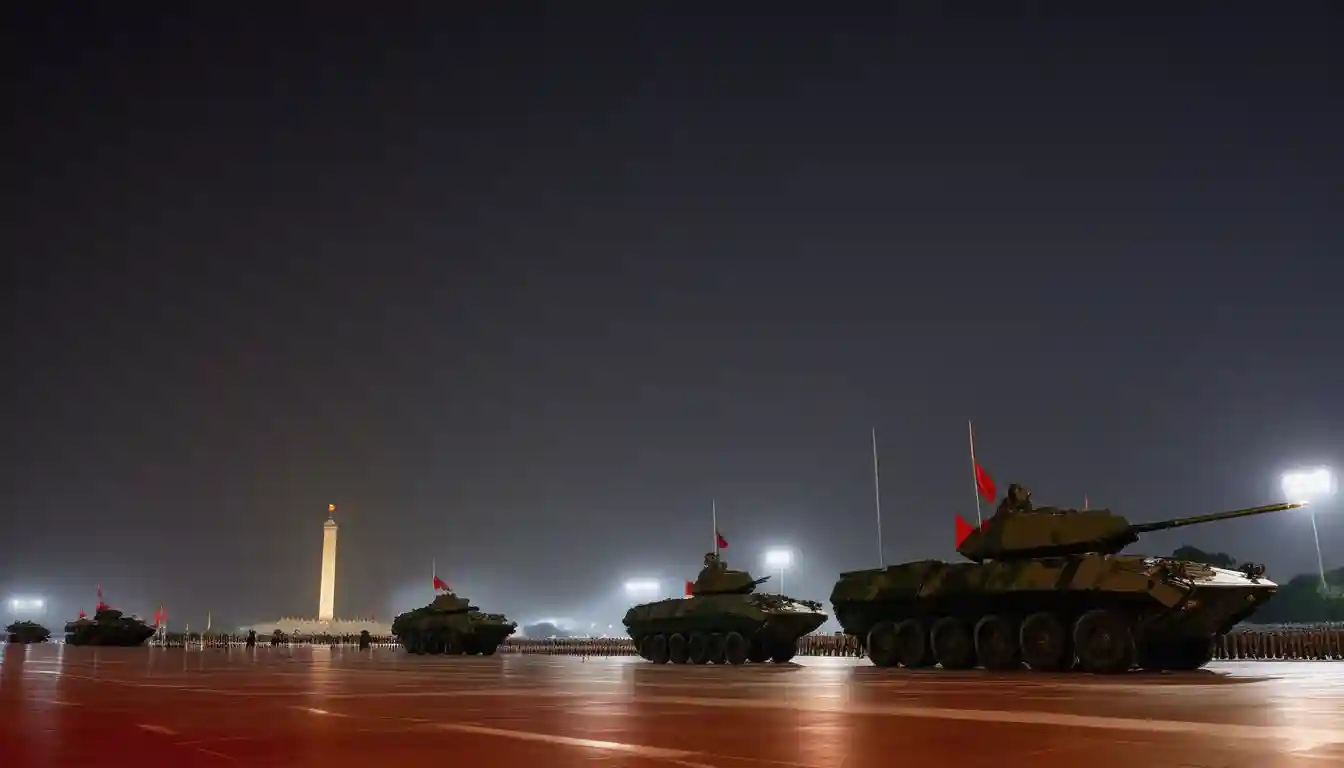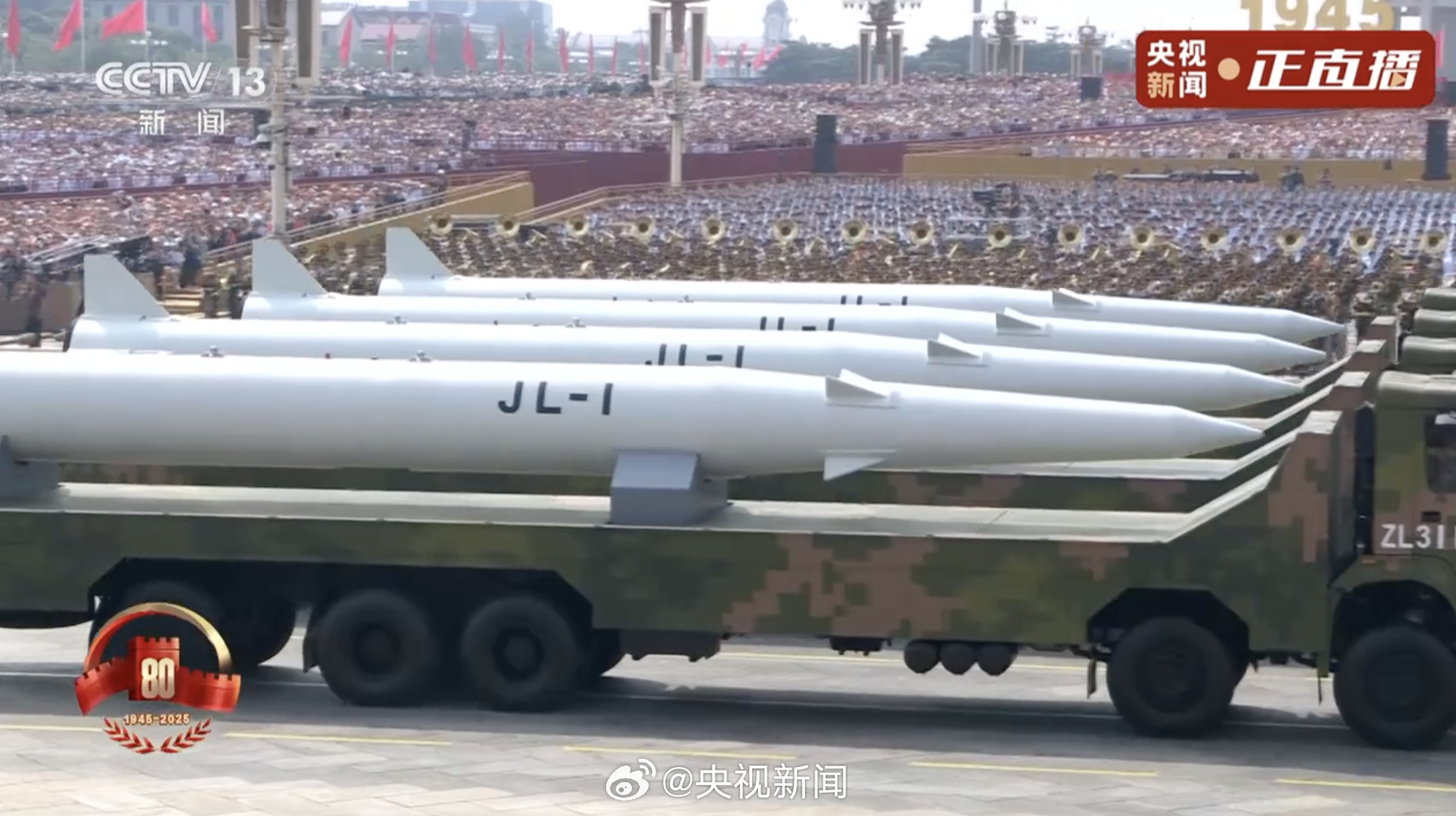
China Unveils Hypersonic Missiles and Laser Weapons at Major Military Parade
The Dragon's New Arsenal: How China's Military Showcase Redefined Pacific Power Dynamics
BEIJING — When the final formation of China's DF-5C intercontinental ballistic missiles rolled through Tiananmen Square on September 3rd, the carefully orchestrated finale carried a message that reverberated far beyond Chang'an Avenue: Beijing has fundamentally transformed its strategic doctrine, pivoting from traditional force projection to a sophisticated multi-domain warfare ecosystem designed to reshape the Pacific theater.

The parade, commemorating the 80th anniversary of Japan's World War II surrender, unveiled a military apparatus that defense analysts describe as China's most significant doctrinal evolution since the 1990s. Unlike previous demonstrations of raw firepower, this showcase emphasized technological integration, autonomous systems, and directed-energy capabilities that signal a new era of warfare—one where traditional military hierarchies may become obsolete.
"What we witnessed represents a complete reimagining of how China intends to project power," said a senior defense analyst who requested anonymity due to the sensitivity of ongoing assessments. "This isn't about matching Western capabilities—it's about leapfrogging them entirely."
The Hypersonic Gambit That Changes Everything
The centerpiece revelation came with the debut of the Jinglei-1, an air-launched hypersonic intercontinental missile that fundamentally alters strategic calculations. Mounted on H-6N bombers, the system enables China to conduct precision strikes from well beyond enemy defensive perimeters—effectively rendering traditional bomber penetration tactics, including America's B-2 stealth doctrine, strategically redundant.

Hypersonic missiles are advanced weapons capable of traveling at least five times the speed of sound (Mach 5). They primarily operate using boost-glide technology, where a rocket propels the vehicle to high altitudes before it glides unpowered at extreme speeds to its target, often with high maneuverability. Defense contractors tracking the implications suggest this capability could compress decision-making timelines in Pacific conflicts to mere minutes, forcing adversaries to maintain constant high-alert postures that strain resources and increase the probability of miscalculation.
The economic implications are profound. Aerospace industry sources indicate that traditional stealth bomber programs, including China's long-rumored H-20, may face budget reallocations as air-launched systems prove more cost-effective per strategic outcome delivered.
Silicon Soldiers: The Unmanned Revolution
Perhaps more transformative than any single weapons system was China's unprecedented showcase of autonomous military platforms. Six distinct fixed-wing unmanned aerial vehicles appeared in formation, including what military observers classified as "unmanned air superiority fighters"—autonomous aircraft comparable in size to manned interceptors and equipped with internal weapons bays.

These systems represent more than technological advancement; they embody a strategic philosophy that prioritizes mass production of intelligent platforms over smaller numbers of exquisite manned systems. Ground formations included integrated teams of robotic vehicles, armed quadrupeds, and drone swarms designed to operate cohesively without human operators—a direct response to lessons learned from contemporary conflicts in Ukraine.
"The operational mathematics change completely when you can field ten autonomous fighters for the cost of one manned platform," noted a former Pentagon acquisition official now working in private defense consulting. "China appears to have solved the autonomy integration problem faster than anticipated."
Table: Comparison of Manned-Unmanned Teaming vs. Pure Autonomous Swarms
| Aspect | Manned Fighter with Autonomous Teammates | Pure Autonomous Swarm |
|---|---|---|
| Core Concept | Human pilot commands a cohort of attritable drones. | Mass of networked, low-cost drones with distributed autonomy. |
| Key Strength | Superior for complex strategic objectives; combines human judgment with drone survivability and sensing. | Superior mass, saturation, and persistence at a lower cost. |
| Primary Weakness | Higher unit cost and reliance on a central, high-value asset. | Limited by autonomy, resilient C2, and vulnerability to countermeasures against adaptive foes. |
| Best For | Penetrating contested airspace, high-stakes missions requiring human judgment and assurance. | Saturation attacks (SEAD/DEAD), broad-area ISR, decoy operations tolerating attrition. |
Investment analysts tracking defense stocks suggest this shift could accelerate consolidation in traditional aerospace manufacturing while creating opportunities in artificial intelligence, sensor fusion, and autonomous vehicle technologies.
Directed Energy: The Dawn of Star Wars Economics
The LY-1 shipborne laser system marked China's entry into operational directed-energy warfare, representing years of advancement in high-energy laser technology that many Western programs have struggled to achieve. Unlike experimental American systems that face cooling and power limitations, China's deployment suggests they have overcome critical engineering barriers using advanced crystal technology previously restricted from export.

The strategic implications extend beyond military applications. Directed-energy weapons fundamentally alter cost-exchange ratios in defensive operations—enabling the destruction of expensive missiles and drones using electricity rather than interceptor missiles costing hundreds of thousands of dollars each.
The cost-exchange ratio in modern warfare quantifies the economic disparity between offensive and defensive assets. This metric is crucial in asymmetric conflicts, where adversaries exploit high ratios, such as the vast cost difference between a drone and an interceptor missile, to gain strategic advantage.
Financial models suggest that widespread laser deployment could drastically reduce ammunition stockpiling requirements while creating new dependencies on advanced power generation and thermal management systems—sectors where Chinese manufacturing capabilities provide significant advantages.
Nuclear Deterrence in the Age of Precision
The parade's finale—massive DF-5C intercontinental ballistic missiles—delivered China's starkest strategic message. These liquid-fueled, silo-based systems represent pure retaliatory capability, designed not for first strikes but for guaranteed second-strike devastation that renders nuclear aggression mathematically irrational.
Unlike mobile launchers optimized for survivability, the DF-5C's fixed deployment creates what strategists call a "strategic sponge" effect—forcing adversaries to dedicate hundreds of their most accurate warheads to neutralize Chinese silos, while uncertainty about which silos contain operational missiles compels attacks on empty installations.
Second-strike capability refers to a nation's ability to retaliate with nuclear weapons even after absorbing an initial nuclear attack. This capability is a cornerstone of nuclear deterrence theory, as it ensures an aggressor cannot gain a decisive advantage from striking first. By guaranteeing a devastating response, it underpins the concept of Mutually Assured Destruction (MAD), making a first strike illogical.
"The DF-5C sends an unambiguous message about escalation costs," explained a former strategic command officer. "Any nuclear exchange becomes total war, making conventional conflicts the only rational domain for competition."
This nuclear backdrop provides strategic cover for Chinese conventional operations, effectively raising the stakes of Pacific confrontations beyond what most democratic societies would accept.
Market Implications: Defense Sector Recalibration
Investment professionals analyzing defense market dynamics suggest China's technological demonstrations will accelerate Western military modernization programs, creating opportunities across multiple sectors. Autonomous systems integration, laser technology development, and hypersonic defense capabilities represent areas where procurement budgets may expand substantially. Projected Growth Areas in the Global Defense Market Following New Technological Arms Race.
| Growth Area | Market Size (Base Year) | Projected Market Size (End Year) | CAGR | Forecast Period |
|---|---|---|---|---|
| Defense Sector (Global) | USD 2494.84 Billion (2024) | USD 3871.25 Billion (2033) | 5.0% | 2025-2033 |
| Autonomous Military Systems | USD 29.06 Billion (2024) | USD 48.08 Billion (2030) | 8.8% | 2025-2030 |
| Hypersonic Weapons | USD 8.24 Billion (2025) | USD 14.78 Billion (2030) | 12.4% | 2025-2030 |
| Directed Energy Weapons | USD 17.11 Billion (2024) | USD 52.88 Billion (2030) | 20.68% | 2024-2030 |
Traditional defense contractors focused on platforms may face challenges as militaries pivot toward distributed, autonomous systems requiring different industrial capabilities. Meanwhile, technology companies specializing in artificial intelligence, quantum computing, and advanced materials could benefit from increased defense spending.
Private equity firms tracking dual-use technologies report heightened interest in companies developing directed-energy systems, autonomous navigation, and electromagnetic spectrum dominance—areas where China's demonstrated capabilities create competitive pressures for Western militaries.
The Doctrine of Technological Deterrence
Beyond individual weapons systems, the parade revealed China's strategic philosophy: technological superiority as the foundation of deterrence. By demonstrating capabilities that appear to exceed Western systems in key areas, Beijing aims to convince adversaries that military confrontation carries unacceptable costs regardless of political objectives.
This approach reflects broader Chinese strategic thinking that emphasizes "winning without fighting"—using demonstrated capability to shape adversary behavior without direct confrontation. The economic efficiency of this approach, leveraging technology development investments across military and civilian applications, provides sustainable competitive advantages in prolonged strategic competition.
The Investment Paradigm
Defense analysts suggest China's technological demonstration will trigger the most significant Western military modernization since the Cold War, with particular emphasis on autonomous systems, directed energy, and hypersonic capabilities. Historical precedents indicate such technological competitions create both risks and opportunities across defense industrial sectors.
Investors may find opportunities in companies developing counter-autonomous systems, laser defense technologies, and advanced manufacturing capabilities required for hypersonic platforms. However, the shift toward software-intensive, rapidly upgradeable systems suggests traditional aerospace manufacturing may face margin pressures as military procurement emphasizes adaptability over durability.
The parade ultimately demonstrated that China's military modernization represents more than technological advancement—it embodies a comprehensive reimagining of how modern militaries should operate, with implications that will reshape defense spending priorities, strategic doctrines, and Pacific security dynamics for decades to come.
House Opinions
| Category | Key PLA Developments | Impact | U.S. Response / Priorities |
|---|---|---|---|
| Nuclear Signaling | Showcased full triad: Jinglei-1 ALBM, JL-3 SLBM, DF-5C MIRV ICBM. | Stronger second-strike credibility, higher escalation costs. | Maintain U.S. triad, enhance BMD, improve ISR on TELs/launch sites. |
| Air-Launched Ballistic Missile (JL-1) | H-6N-carried IRBM-class missile, extends regional strike reach. | Boosts survivability + nuclear signaling. | Target H-6N bases, tankers, ISR nodes; deny launch conditions. |
| Directed-Energy (LY-1 Laser) | Integrated ship/land lasers + HPM + kinetic anti-drone triad. | Strengthens PLA base/ship defense, raises drone attrition costs. | Field U.S. DEWs, exploit weather/aerosols, saturate with swarms. |
| Unmanned Combat Drones | Stealthy “air-superiority” UAVs; some mockups but trend clear. | Potentially shifts future air combat mass dynamics. | Accelerate U.S. CCAs, deploy decoys, EW, and network attacks. |
| Counter-UAS Ecosystem | Dense missile/laser/HPM defenses at key bases & fleets. | Complicates drone raids & saturation tactics. | Mirror triad, push cheap interceptors + automated CUAS C2. |
| Organizational Reforms | New Aerospace, Cyberspace, Info Support Forces; AI-driven kill-web push. | Faster, integrated find-fix-finish cycles. | Harden EMS, develop resilient JADC2 and autonomous ops. |
| Near-Term (0–24 mo) | Hypersonic YJ-19/17/21, hardened CUAS bubbles, louder nuclear posture. | Higher CSG/amphib vulnerability, cost escalation. | Disperse forces, strengthen deception, automate kill-chains. |
| Mid-Term (2–5 yr) | Manned-unmanned teaming, lasers at scale, space-cyber integration. | Shifts OCA/DCA math; faster targeting cycles. | Accelerate CCAs, deploy DEWs, proliferate resilient LEO comms/ISR. |
| PLA Weaknesses | No combat since 1979, integration frictions in autonomy & DEWs. | Systems impressive but unproven under fire. | Exploit C2 fragility, jam datalinks, stress training & logistics. |
| U.S. Priorities | 90 days: Disperse Pacific forces, deploy CUAS triads, harden EMS. 1 yr: Boost munitions, accelerate CCAs, counter-hypersonic layers, resilient space. 5 yrs: Harden bases, field DEWs/HPM, mission-autonomous JADC2. |
For investment decisions, past performance does not guarantee future results. Readers should consult qualified financial advisors before making investment decisions based on geopolitical analysis.